Born of Hope

Rabbi Shlomo Bochner channeled the pain of empty arms to help thousands of childless couples build their families

I was once at one of those dinner planning meetings where people eat sushi and talk vaguely about what should be done, and someone said that they really needed a guest speaker in order to draw a crowd. The organization’s head asked why his speech wouldn’t be as interesting as any paid speaker’s — didn’t he know the challenges better than anyone else? Couldn’t he tell the organization’s story best of all? Yes, someone said politely, he was right in theory, but l’maiseh, that’s not how it works. People want to be entertained, or moved, and they need a name from outside the back office.
The director was frustrated, and a little miffed. “Then how come,” he asked, “at every Bonei Olam dinner, Rabbi Bochner’s speech is the highlight of the night?”
I don’t remember if there was an answer, but now, I think I get it. Rabbi Shlomo Bochner and his wife, Chanie, aren’t telling the story of an organization. It’s their story, and Bonei Olam is part of it. Two people, two hearts, with one shared challenge and one shared goal. Everything else came later.
Rabbi Bochner doesn’t just look like your typical Boro Park businessman, that’s actually what he is — a Bobover chassid with decades of experience in the garment industry as a designer and buyer. And even as he talks of his personal journey — the loneliness and challenge and heartache — there is a certain hesitation. It’s clear he has to push himself to talk.
You may have read that men don’t share emotions easily, don’t share personal feelings with each other. If this is true (it is), then it’s even truer of heimishe men.
At times, he will look to his wife to fill in the words for him, but she doesn’t: She wants him to talk, to convey this story. She needs him to say it, to tell how their own pain became healing for others, and in this way, it healed them too.
The Bochners got married in 1979, with the same dreams of every young couple — the large family, the noise and laughter and action — so the expectation hung around for a while. Sometimes it takes longer. Don’t panic. There are amazing doctors. A few more years of quiet are not the worst thing.
But then it was a few more years and a few more years on top of that and the chorus of reassurance started to fade, and then it was just Reb Shloime and his wife in a car on their way to yet another appointment with their doctor, who asked how the day was going and was it raining and also, he thought they should think in terms of closure because they would not have children.
It was quiet in the car on the way home. What was the point?
Depressing thoughts, Reb Shloime concedes now, but that’s what he was feeling.
As they headed down the FDR Drive toward Brooklyn, Chanie spoke first. “Shloime, for 20 years now, we’ve been working and gathering information. We know all the treatments, we have cell-phone numbers that no one else has, we have connections and experience. It’s time to share it with others.”
Now, sitting in their tasteful home, Rabbi Bochner looks at me and says, “What can I say? I wasn’t there yet. She was. She was ready.”
Like the next day type of ready. Reb Shloime came home from selling coats to see a group of women gathered around his kitchen table.
“I didn’t doubt that she was right about the need, I knew that infertility was taboo in the community in the late ’90s, the elephant in the communal room. It needed someone to take it on, but I didn’t think I was that someone. I’m not a fundraiser or administrator,” says the man now responsible for a ten-million-dollar budget.
He remembers a conversation with one of the prominent poskim of the time, an older, respected rav. Reb Shloime asked his sh’eilah, a fertility issue with serious halachic ramifications. The rav looked up and said honestly, “Ich veis nisht vus di redst, I have no idea what you’re talking about.”
“Boro Park was the loneliest place in the world for a couple facing infertility — it was like we were living on our own planet.” His features soften for a moment. “But there was one person who understood. My rebbe. That was it.”
The Rebbe, Rav Shlomo of Bobov, heard the pain of his young chassid.
“His advice was always to go b’temimus, to go with traditional Yiddishe tools and not try to do more than humanly possible. He let me know he understood the pain and loneliness, and we had many long conversations.”
Once, the chassid was traveling to Eretz Yisrael and he sought the Rebbe’s brachah. “Shloime,” the Rebbe said gently, “go to the kevarim, go to the mekomos hakedoshim, say some Tehillim… and more than that you can’t do.”
More than that you can’t do.
Once, when disappointment had already given way to despair, Reb Shloime came in to the Rebbe, who remarked, “A Yid has to be b’simchah. The Torah says so.”
“Rebbe,” Rabbi Bochner asked, “is it really possible to be b’simchah in this situation?”
The Bobover Rebbe placed his hands over his face, lost in thought. Then, he spoke. “You know what, Shloime? You’re right… but af al pi kein… a Yid has to work on it.”
Al af pi kein…the secret of the Bobover Rebbe’s radiant smile, and the secret of this couple, seated across from me, and the smiles they’ve brought to thousands of families.
At the Right Time
It was Erev Yom Kippur, a few months after Mrs. Bochner started speaking with families facing similar challenges, but her husband still wasn’t on board.
Yet as he was headed out to shul for Kol Nidrei, moments before Yom Kippur was to begin, she stopped him at the doorway. “Shloime, I need you to do this with me. Please.”
In his tallis and kittel, the awe of the impending day spread out like a blanket around him, he nodded. “Okay,” he said finally.
“I’m not a therapist, but I realize what Chanie was doing for me,” Rabbi Bochner reflects, sharing these profundities while spreading cream cheese on a bagel. He has only one setting — completely direct and candid — and there’s no indication that he’s uncomfortable sharing this.
“A person needs hope, something to live for… and once we got our diagnosis, she simply took the hope that had carried us until then and gave us something else to hope for. We started to live for other people and their chance of becoming parents.”
First it was just listening. “Therapists and rabbanim are great and they give chizuk, but let’s be honest, you can’t understand this parshah if you don’t know it personally.”
The Bochners knew a lot, not just about infertility, but about how to access doctors — and they helped with that too. But one day, a couple asked to borrow money to fund treatments.
“We didn’t have much, I’d been working several jobs to pay for our own 20-year struggle to have children, and I didn’t think we could help,” Reb Shloime reflects. “Then Chanie looked at me and said, ‘Shloime, they have a real chance to have children but they might lose it, they’re in the middle of a cycle and their window is closing…we can’t let that happen because of money.’ So we found money to lend them.”
The couple came home with twins. And the Bochners saw what a few dollars at the right time could do.
Bonei Olam, “Builders of Worlds,” can come across as a presumptuous name for an organization — except that it’s true. They were building worlds and so they never looked back.
It wasn’t just the listening ear, the money, or the expertise. “People are intimidated by top doctors, like they’re a different species,” says Reb Shloime. “They’re not. You just have to know how to work with them.”
Rabbi Bochner learned early on that a private cell-phone number isn’t enough. “There’s no match for personal advocacy. I would try to catch them on the way into work, or after hours, and explain the cause. Most good doctors want to make a difference, that’s what they signed up for. I don’t think any doctor ever told me no.”
There was ironic, bittersweet joy of helping couples experience parenthood — even couples facing the very same diagnosis that had stymied the Bochners.
“That wasn’t easy, working through the realization that if an organization like Bonei Olam had been around, maybe our destiny would have been different…. that’s where emunah comes in. It made us stronger, and gave us a clear sense of our mission,” Rabbi Bochner says. “You know, people think I’m a rock, that I have no feelings. I’m really very weak,” he adds, and his wife looks up and laughs out loud.
You’re All In
Mrs. Bochner realized that they needed to make a fundraising event for a cause that, in 1999, was not yet popular or out there.
“But it turned out that quietly, people were aware of it. There were many families affected by it. And early on,” she says, “we learned how to welcome people to our team. Today we have offices across the world, and most of our staff members continue to be volunteers. People are generous, they’re helpful, they’re amazing. Even if at the start, it was awkward to explain what we were doing, today, they all feel like they’re building homes and lives.”
It meant suggesting treatment, making the connections, then funding treatment — and suddenly, new doors were swinging open.
“You know how it is, once you know a little bit, people expect you to know a lot, and we started getting calls about shidduchim, about researching genes and mutations,” says Reb Shloime. “Every time you can identify a gene that causes an issue, if you can test and see that a young man or woman doesn’t have that gene, then you can move forward on a shidduch with confidence, right? So I threw myself into that too, creating a staff of researchers focusing on genetics-related issues in the wider frum community. We used our know-how to create new relationships with labs and medical centers, and to date, over 30 new genetic mutations have been identified through our efforts.”
Infertility, it turned out, was the intersection between pain and pain. “Cancer became our expertise as well, because we suddenly had parents of a child or a teenage cancer patient who needed guidance about the patient’s ability to have children in the future, and people were like, ‘Oh, call Bonei Olam,’ so we did that too, figured out the halachic and medical ramifications and made it possible.”
Rabbi Bochner isn’t one for casual schmoozing, leaving the social niceties to his wife. At one point, when I ask a detail about the founding of the organization, he waves his hand and says, “That’s not interessant.” I understand this better when he remarks, “This area of askanus isn’t halfway. If you’re in, you’re all the way in. No vacations. No breaks. No turning the phone off. And we were in.”
He’s not here to do nostalgia. He’s all in.
In, says Mrs. Bochner, means that her husband might be at a show in Hong Kong, browsing racks of new coats while clutching his cell phone, on a conference call with a doctor and a hopeful couple.
Originally, she admits, when she pulled him in, she signed a shtar, a contract with him, that would allow him to step back if it was too much. The only condition in that document that’s actually been kept is the stipulation that, until today, the Bochners don’t take a salary from Bonei Olam.
Being all in means that there is always a sense of urgency.
“The stakes are too high to mess up or slack off,” Mrs. Bochner says. “Sometimes I’m trying to get an appointment for someone and the receptionist is pushing me off, but it’s not an option to let that happen. I spend time fighting the insurance companies — they think IVF is a procedure like cosmetic surgery, that it’s not that vital, so it’s always a battle. I feel like I’m always at war with them.”
When she says this, I have an image of the person at the other end of the phone and I pity them.
“Tooth and nail,” says Rabbi Bochner with a tinge of pride, “she fights for her patients.”
Two Pockets
Along with the backend, the doctors and lab reports and tests, aside from the administration and fund-raising, came a new challenge — diplomacy. Rabbi Bochner, ambassador of the organization, figured it out quickly. “Because people in Crown Heights need help, people in Teaneck need help, and people in Williamsburg need help. If you keep getting held up by intra-frum politics, the people who need it won’t get help.”
The reserved Bobover chassid learned that true empathy doesn’t wear a shtreimel or beketshe, and that he had a new family forming quicker than he thought possible.
There was the phone, couples waiting on the front steps at night, and shy people shuffling around in the back of shul, asking for a moment of his time.
“Infertility doesn’t differentiate between rich and poor, prominent families or great rebbes,” he says. “I remember approaching a wealthy man for a donation, and I told him a bit about what we were doing. ‘Oh please, today people start organizations because they’re bored, they need something to do, this doesn’t speak to me,’ he said. That was that. I was hurt, but Rav Moshe Zoberman, a respected maggid shiur and talmid chacham in Bobov who was a mentor to me, told me that if I was raising funds, I had to have two pockets: one for money and one for bizyonos. I tried not to let it bother me.”
Some time later, at a wedding, Reb Shloime was sitting by the chuppah when he sensed someone sliding into the chair next to him. It was this same philanthropist, who was mumbling about a genetic issue and needing help and someone who suggested he speak to Bochner. “He was just a person who needed help, and that’s all I saw at that moment. So we tried.”
Reb Shloime quotes another piece of wise advice from Rav Zoberman. “He suggested that I travel to Eretz Yisrael and meet Rav Shmuel HaLevi Wosner ztz”l, which was extremely helpful. Having a presence in Eretz Yisrael allowed us to help so many more people, people who had never believed help was possible.”
Rav Wosner, several generations older than the people Bonei Olam was servicing, understood not just the halachic and practical ramifications of every case, but even the emotional effects. He wrote the basic protocol for Bonei Olam and charged his talmid, Rav Moshe Shaul Klein (the current head of Rav Wosner’s beis din), with serving as the rav of the Israeli branch.
The creation of the Israel office exposed Reb Shloime and his wife to another special relationship. Reb Shloime seems to shrink, as if in humility. “We would go in to Rav Aharon Leib Steinman and it was like a jolt of chizuk — our relationship was like that of a father and son. Somehow, he understood us, understood not just the topic but the realities of life for us, so he was always extremely upbeat and encouraging.”
And so, so honest.
Once, Rav Aharon Leib told Rabbi Bochner, “Shloime, why do we need Bonei Olam? If Hashem wants someone to have children, then they will have. If He doesn’t, then they won’t. So vos iz di ganzte shpiel?” And then Rav Steinman answered his own question: “Maybe, Reb Shloime, maybe you’ll feel the tzaar and pain of another and make it your pain, and that itself opens new gates and creates new zechusim. Maybe that’s what you’re doing.”
Dance with Your Child
Often, Bonei Olam will match up a couple who needs financial assistance with a donor, offering the zechus to potentially sponsor human life. “I was once in a certain shul and I saw a man who I thought could help. I approached him and asked if he would sponsor the treatments for another person in that shul, though I didn’t tell him who, of course. He agreed.”
Donors can get a pin number of the couple they’re assisting, in order to chart progress, but that’s as much information as they can get.
“But on Simchas Torah two years later, I went back to that same shul,” Reb Shloime recalls. He approached the glowing new father, dancing with his newborn son in his hands, and asked if they could tell the donor the truth about whom he’d helped.
The father instantly agreed and Reb Shloime carried the tiny baby over the donor. “Dance with your child,” said Reb Shloime, “take him and dance on Simchas Torah.”
The donor looked confused, but only for a moment. Then, with shaking arms, he took the child and they formed a little circle, he, the father, and Reb Shloime, the one in whose heart they’d been joined together.
Rav Steinman widened the organization’s net yet further.
“He suggested that we connect singles waiting for their shidduchim with couples waiting for children, the singles funding treatment and the couples davening for the singles. The Rosh Yeshivah quoted the pasuk, ‘Ulai ibaneh mimenah — Maybe I will be built from her.’ When Sarah Imenu gave Hagar to Avrahom Avinu, she herself merited a child.
For the Bochners, involved in hard data and medical minutiae, it seemed beyond the scope of their mission, but Rav Aharon Leib asked again and then a third time. “Listen to me, you will see great siyata d’Shmaya,” the aged rosh yeshivah pleaded.
On his return to America, Reb Shloime shared the Rosh Yeshivah’s directive with his close friend and bungalow-colony neighbor, Rabbi Chaim Aryeh Zev Ginzberg. Rabbi Ginzberg heard, and hurried home to speak to his rebbetzin.
Within half an hour, they asked for the zechus to form Ohel Sara’la, carrying the name of their beloved daughter Sara’la a”h, and within the month, Rabbi Ginzberg took to the pages of this magazine to launch the innovative plan.
“It started slow,” says Reb Shloime, “but after Rav Steinman’s petirah, it really picked up. Over a thousand shidduchim were made since it was launched.”
And this, in a way, is part of the Bonei Olam story too, a huge circle of dancing Jews — invisible, eternal lines connecting them with this couple who sit and calmly sip coffee as if we are discussing trends in the garment industry rather than the international army of neshamos they have spawned.
Our Partner
Today, along with the main headquarters in Boro Park, there are 13 offices internationally, including Canada, Europe, Australia, and Israel. Most of the offices have a few full-time workers, but there is a support staff of caseworkers, mostly volunteers, backing them up.
It always starts with a phone call, but, if the situation calls for it, the intake specialist will then assign the caller a counselor that will walk the couple along the path of diagnosis, halachah, and then treatment. Though Rabbi Bochner knows about every case, more recently he is only involved in the most complex situations.
This year, Covid-19 brought its own unique challenges.
“Everything went haywire. Appointments were canceled, and for people on a certain schedule, that can be devastating,” said Mrs. Bochner. “Next month is not the same as this month. The labs were shut down, the medical staff unavailable.”
And the donations tried up too. Wealthy people suddenly worried about their own businesses and investments.
“The Ribbono shel Olam has always been our partner, and I went back to Him. ‘For 21 years I’ve been doing this,’ I said, ‘I didn’t ask for it. You sent me here, You gave me a mission and I’m trying. Tell me, Bashefer, what I should do now?’ ”
Then came V’zakeini, a program in which women pledge one dollar before candle lighting on Erev Shabbos, which was not just a financial help, bringing in over twenty thousand dollars every Friday, but much more than that to Bonei Olam’s founders.
“Those are the most exalted moments in the week,” Reb Shloime says. “There’s a ‘ra’ash,’ a commotion in Shamayim as Shabbos descends, and the thought of thousands of Jewish women finding room in their hearts and in their tefillos for us… the chizuk we get from this campaign has carried us through these last few months.”
Early on, it was hard for the Bochners because they were breaking barriers that were never broken down for them.
Today, they see it differently. Two decades in, they see every baby born as an answer to the doctor who spoke to them of closure. If one path was blocked, 9,542 new ones opened since.
Additionally, infertility specialists from across the world now turn to Bonei Olam for direction, and the organization and its in-house team has contributed to many studies. A new generation of poskim has been trained at the regular sessions hosted by Bonei Olam, and they are ready and able to guide couples through the difficult maze of infertility.
There is a knock on the front door, and as Mrs. Bochner rises to open it, there is another knock on the glass porch door in back.
Somehow, she opens both doors and comes back to where her husband is sitting with me.
“Can you believe it?” she asks brightly, “at one door there is a meshulach and at the other, a little girl is selling flowers for tzedakah! We must be doing something right, Shloime, if Hashem is sending us two zechusim at once, no?”
She rummages around in her wallet as her husband reaches into his pocket, the question hanging there.
He shrugs softly. “Maybe,” he says, “maybe.”
Common Act, Common Hope
To be honest, I’d always wanted to interview the Bochners, but they seemed unreachable. I had tried at various times over the years, and they were too busy, or not ready to talk, but over this past summer, there was a campaign that drew widespread interest. During the most auspicious moments of the week, as Friday’s bustle and commotion suddenly gives way to Shabbos’s serenity, the clouds of peace descend on Jewish homes as mothers place a few coins in the pushke before reaching out to ignite the flame of Shabbos.
It’s more of a private time, not a great moment for national campaigns, but somehow, the “Vezakeini” campaign — one dollar a week from eighteen thousand women that could fund a treatment for a couple hoping for children — felt right. Jewish women joined not just in common action and common hope for their own children, but in determination to help their sisters experience motherhood as well.
The concept grew out of a single moment. Bonei Olam’s director of marketing Rabbi Boruch Goldberger was sitting at the Siyum HaShas in January, contemplating the request made in the hadran — that the Torah not weaken in the mouths of our children and their children — and the plight of those who don’t yet have children. “If every person in this stadium gave a dollar,” he thought, “we could help so many more couples.”
That led to the launch of a program asking for one dollar. The response was quick and generous, eighteen thousand becoming twenty-five thousand, each dollar bill a note of chizuk, compassion, and empathy.
“Aside from helping these couples,” Rabbi Goldberger reflected, “we accomplished something else. Not everyone can afford to cover treatment for a couple, and until now, only wealthy donors had the zechus of enabling a family to be built. Now, every person can be part of it. For one dollar, you can earn that merit as well.”
Against this backdrop, out of gratitude to the masses of Jewish women who’ve partnered with them and their families, the Bochners felt ready to share their story.
(Originally featured in Mishpacha, Issue 832)
Oops! We could not locate your form.








Comments (2)